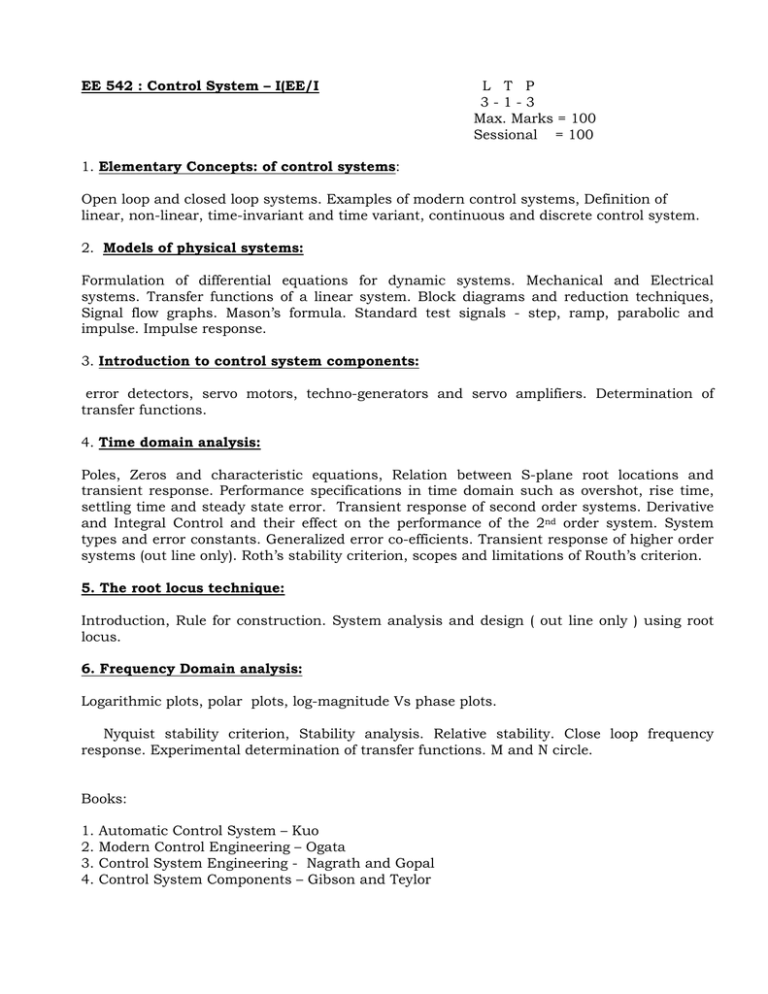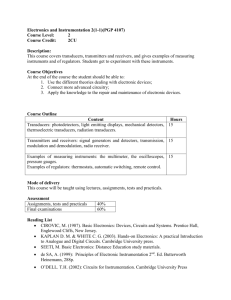EE 542 : Control System – I(EE/I L T P 3 - 1
advertisement

EE 542 : Control System – I(EE/I L T P 3-1-3 Max. Marks = 100 Sessional = 100 1. Elementary Concepts: of control systems: Open loop and closed loop systems. Examples of modern control systems, Definition of linear, non-linear, time-invariant and time variant, continuous and discrete control system. 2. Models of physical systems: Formulation of differential equations for dynamic systems. Mechanical and Electrical systems. Transfer functions of a linear system. Block diagrams and reduction techniques, Signal flow graphs. Mason’s formula. Standard test signals - step, ramp, parabolic and impulse. Impulse response. 3. Introduction to control system components: error detectors, servo motors, techno-generators and servo amplifiers. Determination of transfer functions. 4. Time domain analysis: Poles, Zeros and characteristic equations, Relation between S-plane root locations and transient response. Performance specifications in time domain such as overshot, rise time, settling time and steady state error. Transient response of second order systems. Derivative and Integral Control and their effect on the performance of the 2nd order system. System types and error constants. Generalized error co-efficients. Transient response of higher order systems (out line only). Roth’s stability criterion, scopes and limitations of Routh’s criterion. 5. The root locus technique: Introduction, Rule for construction. System analysis and design ( out line only ) using root locus. 6. Frequency Domain analysis: Logarithmic plots, polar plots, log-magnitude Vs phase plots. Nyquist stability criterion, Stability analysis. Relative stability. Close loop frequency response. Experimental determination of transfer functions. M and N circle. Books: 1. 2. 3. 4. Automatic Control System – Kuo Modern Control Engineering – Ogata Control System Engineering - Nagrath and Gopal Control System Components – Gibson and Teylor EE 541: DIGITAL SYSTEMS (EE/IE) L T P 3 1 3 Max. Marks = 100 Sessional Marks = 50 Laboratory Marks = 50 1. Number system: Number base conversion, Binary numbers, octal and hexadecimal numbers, complements, signed binary numbers, Binary codes, floating point numbers and arithmetic. 2. Boolean algebra and logic gates: Basic theorems and properties of Boolean algebra, Boolean functions, canonical and standard forms-SOP & POS. Logical operations, truth tables, logic gates, logic levels and pulse waveforms, pulsed operation. 3. Simplification of Boolean functions: The map method- the Karnaugh map, minimal SOP & POS, Don’t care conditions, multiple output minimization, tabular method, Quine-Mcclusky method, determination and selection of prime implicants. 4. Combinational Logic: (Logic synthesis): Introduction, universal property of NAND and NOR gates, AND-OR networks, NAND & NOR networks, EX-OR networks, design and analysis of combinational logic. 5. Functions of combinational logic: Adders & substractors, parallel binary adders, magnitude comparator, code conversion, decoders & encoders, Multiplexer & demultiplexers, parity generators & checkers. Read only memories PLA & PAL 6. Synchronous sequential logic: Introduction: S-R, J-k, D and T Flip Flops, Excitation table, Triggering of F/Fs & Latches, One shot Astable multivibrator. 7. Registers, Counters and Memory Units: Registers: - Shift – Registers, Ripple Counters, Synchronous Counters. Ring Counters, Timing Sequences, Design Procedure, Random Access Memory, Memory Decoding. 8. Digital integrated Circuit: Introduction, special characteristics (Fan-Out, Power dissipation, Propagation delay, figure of merit, noise level) Introduction to TTL, ECL, MOS, and CMOS circuit. Books: 1. 2. 3. 4. Digital Design – M. Marris Mano. Logic Design Theory – NN Biswas Digital Fundamental – TL Floyd Digital Electronics- R.P.Jain. IE 552: Electronic Instrumentation L T P 3 10 Max. Marks=100 Sessional = 50 Basic principle of analog electronic instruments: peak, rms and average-reading type voltmeter, Q-meter and distortion meter, vector impedance meter, vector voltmeter.. Operational Amplifiers: Characteristics & Circuit Configurations. Instrumentation amplifiers and their applications. Active filters and their design considerations-: low pass, band pass and high pass filters. Function generators: square wave, triangular, saw tooth type pulse and square wave generators. Sweep frequency generator. Analogue and digital data acquisition systems: Interfacing transducers to electronic control and measuring systems.DC and AC signal conditioning circuit, Analog to Digital (A/D) and Digital to Analog (D/A) converters. PLL, voltage to frequency and frequency to voltage converters: Lock-in amplifier and its application, digital frequency meter, wave and spectrum analyzers harmonic distortion analyzer, heterodyne harmonic analyzer. Strip-chart recorder, x-y recorder. Books: 1. Electrical and Electronic Instrumentation: Swahney, A.K. 2. Modern Electronic Instrumentation and Measurement Techniques: Helfric AD and Cooper WD, PHI, 1992 3. Instrumentation, Measurement and Feedback :Jones BE, 4. Op-Amp and Integrated Ckts:Gayakwad RA,PHI,N.Delhi 5. Electronic Instrumentation : Kalsi, TMH IE 551: Instrumentation Systems Components – I L T P (3 1 3) Max. Marks = 100 Sessional Marks= 50 Lab Marks= 50 Transducers: classification. Resistance transducers. Resistance potentiometers. RTD and thermistors. Strain gauges and their application in pressure, force and torque measurements. Load Cells. Hot wire anemometers and associated circuits. Inductive transducers: Types of inductance transducers and their principles of operation. LVDT and phase sensitive detectors. Variable reluctance type transducers. Push-pull arrangement and reduction of non-linearity. Associated circuits. Capacitive transducers:Air gap and dielectric type. Capacitance Bridge. Capacitance microphone and associated circuits. Piezoelectric transducers-: principle of operation, frequency response and Applications. Elastic transducers: springs, bellows, diaphragms and Bourdon tube. Combination of elastic and electric transducers. Thermocouple: Characteristics, installation and compensation. Measuring Circuits. Magnetostrictive transducers: applications in flow measurements. Different types of flow transducers and their principles of operation. Transducers for acceleration, vibration and shock Digital transducers. References/Books: 1. Measurement Systems: Application and Design: Doebelin E O, TataMcGraw 2. Transducers and Instrumentation: Murthy DVS, PHI New Delhi 3. Sensors and Transducers: Patranabis D, Wheeler, 1996. 4. Instrumentation, Measurement and Feedback: Jones, BE, TMH EE 543: POWER ELECTRONICS (EE/IE) L T P 3 1 3 Theory Marks= 100 Sessional Marks=50 Lab=50 Time= 3 hours. 1. Operational Amplifier: Features of an ideal, OP- AMP and typical applications, definitions of important terms including voltage and current off – sets, common- mode range, common – mode rejection ratio, power supply rejection ratio, slew rate, Zener diode voltage reference and voltage/ current sources in OP- AMP. 2. Regulated D.C. Power supplies: Requirements and principles Constant voltage and current regulators, use of ICs, Line regulation, introduction to switching regulators. 3. Semiconductor Power Devices: Introduction, power diodes, power transistors and SCRs and their operations, GTOs, Triacs and other types of thyristors, their characteristics, ratings, mounting and cooling. Series and parallel connections of SCRs. Triggering and control. 4. Converter Operation with SCRs: Single phase half- wave, full- wave and bridge circuits, three- phase half wave and bridge circuits, six- phase with interphase transformer, fully controlled and half- controlled circuits. Effects of load and source inductance. Dual converter and cycloconverter operating modes. Line commuted inverters, firing and control circuits for different operations. 5. Forward commutation and Forced: Commutated inverters: Forced commutation circuits, parallel, series and bridge (singlephase and three- phase) inverters, McMurray and McMurray- Bedford inverter circuits, Voltage and current source inverters. Output voltage control harmonics eliminations. Firing circuits for inverters. 6. Choppers: Principles of operation, classification, DC, AC, and multi- quadrant choppers, Morgan’s, Jones, and Mazda’s choppers. Application. 7. Applications of SCRs: SCR battery chargers, replacement of electromechanical devices by SCRs. References: 1. 2. 3. 4. 5. 6. Gray, P.E.&c.L.Scurle: Electronic Principles- Wiley Eastern. Grabane, A.B.:Analog integrated Circuit Degign- Van Nortrand. Ramamoorthy, m.: An Introduction to Thyristors and their Applications- East West Press. Rashid, M.H. Power Electronics, Circuits, Devices and Applications- Prentice Hall of India. Sen, P.C.: Power Electronics- TMH. Dubey et al; Thyristorised Power Controllers- Wiley Eastern..
